Intel Xeon E5-2687W v3 and E5-2650 v3 Review: Haswell-EP with 10 Cores
by Ian Cutress on October 13, 2014 10:00 AM EST- Posted in
- CPUs
- IT Computing
- Intel
- Xeon
- Enterprise
- Enterprise CPUs
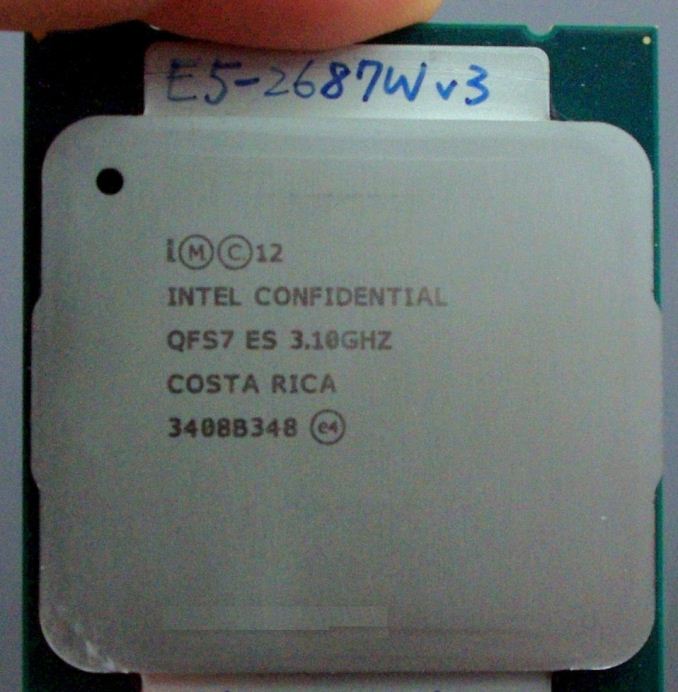
During September we managed to get hold of some Haswell-EP samples for a quick run through our testing suite. The Xeon E5 v3 range extends beyond that of the E5 v2 with the new architecture, support for DDR4 and more SKUs with more cores. These are generally split into several markets including workstation, server, low power and high performance, with a few SKUs dedicated for communications or off-map SKUs with different levels of support. Today we are testing two 10 core models, the Xeon E5-2687W v3 and the Xeon E5-2650 v3.
Intel Xeon E5 v3: The Information
Our initial Haswell-EP coverage from Johan was super extensive and well worth a read for anyone interested in the Xeon platform. My focus here will be light in comparison, mentioning key points that as an ex-workstation user I find interesting. This will be the first of several reviews on the Xeon processors, which we have split up to focus more on each area.
The core layouts for each of the different levels of processor are from three designs, emulating the single and dual ring bus type arrangements depending on the number of cores in each SKU. As with the Xeon E5 v2 processors, the big block of cache is in the middle of the cores and data is transferred via the ring bus. From the core designs, pairs of cores can be disabled to make lower core count CPUs, and much like the previous generation, some low core / high cache models might be possible.
In the 10-12 core image above we essentially get two classes of cores – one in the big stack to the left and another to the right. The processor is designed to treat all cores equally, although the Cluster on Die snoop mode new to E5 v3 will organize the cache data into what acts like two big sections in a NUMA style-arrangement. This allows data relevant to cores that need it to stay close and hopefully reduce read/write latencies, but is all transparent to the user. Johan goes into more detail on this front in his review.
This column arrangement is also why we do not see the progressive jump in cores we would expect. In the consumer space, we have had 1, 2, 4, 6, 8 cores, and one might expect 12 and 16 on the horizon, but 10, 14 and 18 seem a little off canter, along witht the 15-core design from Ivy Bridge-EP. Using this column design, Intel has to balance the number of cores per ring and the number of cores per column. In the large 18 core design there are 10 cores in the secondary ring and six in a single column – ideally fewer columns would be preferable however more rings allows data to transfer more frequently. It becomes a bit of a balance in terms of design, efficiency, performance and yield at the end of the day, especially when dealing with up to 5.69B transistors in 662 mm2.
| CPU Specification Comparison | |||||||||
| CPU | Node | Cores | GPU | Transistor Count (Schematic) |
Die Size | ||||
| Server CPUs | |||||||||
| Intel | Haswell-EP 14-18C | 22nm | 14-18 | N/A | 5.69B | 662mm2 | |||
| Intel | Haswell-EP 10C-12C | 22nm | 6-12 | N/A | 3.84B | 492mm2 | |||
| Intel | Haswell-EP 6C-8C | 22nm | 4-8 | N/A | 2.6B | 354mm2 | |||
| Intel | Ivy Bridge-EP 12C-15C | 22nm | 10-15 | N/A | 4.31B | 541mm2 | |||
| Intel | Ivy Bridge-EP 10C | 22nm | 6-10 | N/A | 2.89B | 341mm2 | |||
| Consumer CPUs | |||||||||
| Intel | Haswell-E 8C | 22nm | 8 | N/A | 2.6B | 356mm2 | |||
| Intel | Haswell GT2 4C | 22nm | 4 | GT2 | 1.4B | 177mm2 | |||
| Intel | Haswell ULT GT3 2C | 22nm | 2 | GT3 | 1.3B | 181mm2 | |||
| Intel | Ivy Bridge-E 6C | 22nm | 6 | N/A | 1.86B | 257mm2 | |||
| Intel | Ivy Bridge 4C | 22nm | 4 | GT2 | 1.2B | 160mm2 | |||
| Intel | Sandy Bridge-E 6C | 32nm | 6 | N/A | 2.27B | 435mm2 | |||
| Intel | Sandy Bridge 4C | 32nm | 4 | GT2 | 995M | 216mm2 | |||
| Intel | Lynnfield 4C | 45nm | 4 | N/A | 774M | 296mm2 | |||
| AMD | Trinity 4C | 32nm | 4 | 7660D | 1.303B | 246mm2 | |||
| AMD | Vishera 8C | 32nm | 8 | N/A | 1.2B | 315mm2 | |||
Intel should be offering certain configurations with more L3 cache, given that in their press materials the one they labelled '10C-12C' will actually be offered as a cut down to six cores for release. These CPUs, whichever way you slice them, are still massive.
Today our review revolves around two of the 10 core options from Intel.
| Intel Xeon E5 v3 SKU Comparison | ||||
| Xeon E5 | Cores/ Threads |
TDP | Clock Speed (GHz) |
Price |
| High Performance (35-45MB LLC) | ||||
| 2699 v3 | 18/36 | 145W | 2.3-3.6 | $4115 |
| 2698 v3 | 16/32 | 135W | 2.3-3.6 | $3226 |
| 2697 v3 | 14/28 | 145W | 2.6-3.6 | $2702 |
| 2695 v3 | 14/28 | 120W | 2.3-3.3 | $2424 |
| "Advanced" (20-30MB LLC) | ||||
| 2690 v3 | 12/24 | 135W | 2.6-3.5 | $2090 |
| 2680 v3 | 12/24 | 120W | 2.5-3.3 | $1745 |
| 2660 v3 | 10/20 | 105W | 2.6-3.3 | $1445 |
| 2650 v3 | 10/20 | 105W | 2.3-3.0 | $1167 |
| Midrange (15-25MB LLC) | ||||
| 2640 v3 | 8/16 | 90W | 2.6-3.4 | $939 |
| 2630 v3 | 8/16 | 85W | 2.4-3.2 | $667 |
| 2620 v3 | 6/12 | 85W | 2.4-3.2 | $422 |
| Frequency optimized (10-20MB LLC) | ||||
| 2687W v3 | 10/20 | 160W | 3.1-3.5 | $2141 |
| 2667 v3 | 8/16 | 135W | 3.2-3.6 | $2057 |
| 2643 v3 | 6/12 | 135W | 3.4-3.7 | $1552 |
| 2637 v3 | 4/8 | 135W | 3.5-3.7 | $996 |
| Budget (15MB LLC) | ||||
| 2609 v3 | 6/6 | 85W | 1.9 | $306 |
| 2603 v3 | 6/6 | 85W | 1.6 | $213 |
| Power Optimized (20-30MB LLC) | ||||
| 2650L v3 | 12/24 | 65W | 1.8-2.5 | $1329 |
| 2630L v3 | 8/16 | 55W | 1.8-2.9 | $612 |
The E5-2687W v3 is an interesting model of the bunch, particularly due to the importance of the E5-2687W v2 from the previous generation. The v2 version was lauded due to the difference in peak frequencies compared to the higher core count models, but this changes with Haswell-EP.
For Ivy Bridge-EP:
- The 8-core E5-2687W v2 gave 3.6 GHz in full-load, TDP of 150W for $2108,
- The 12 core E5-2697 v2 gave 3.0 GHz in full-load, TDP of 130W for $2614
With Haswell-EP:
- The 10-core E5-2687W v3 gives 3.2 GHz for 160W at $2057,
- The 14-core E5-2697 v3 gives 3.1 GHz for 145W at $2702 or
- The 18-core E5-2699 v3 gives 2.8 GHz for 145W at $4115
If we compare the difference between the E5-2687W and E5-2697, first with v2 and then v3, it makes the new Haswell ‘W for Workstation’ CPU a little less enticing. Previously it was a trade-off between cores and frequency, and depending on the software having a high turbo mode helps with the v2 CPUs.
To make matters worse for the E5-2687W v3, if we compare single thread speeds, the E5-2697 v3 reaches 3.6 GHz compared to the E5-2687W v3 at 3.5 GHz, which puts the W processor at a disadvantage.
It is worth noting that Intel puts these two processors in different parts of the product stack, to technically they should not be 'competing' against each other:
The E5-2687W v3 is firmly for Workstations only, rather than servers, whereas the E5-2697 v3 should end up in 2U servers.
The other processor in this review, the E5-2650 v3 sits in the ‘Advanced’ section in the SKU stack, giving 2.6 GHz at load or 3.0 GHz for single threaded speed, but lists at only 105W for $1166 tray price.
Using this information and a few SKUs that are off-roadmap, the turbo modes of the 10 core processors are:
All the 10 core processors reach their full-core turbo when five cores are in use, and are on the top turbo frequency when one or two cores are active.
The Chipset
When we reviewed a pair of the E5 v2 processors back in March, the main server based chipsets at the time revolved around the C600 series, codename ‘Patsburg’. For the v3 processors, this moves to the C610 series, also known as Wellsburg. The C612 chipset is the primary server component at this point, offering many of the features we have already seen in our X99 reviews:
- Up to 10 SATA 6 Gbps,
- 6 ports of USB 3.0,
- 8 ports of USB 2.0
- Up to 8 PCIe 2.0, with x1/x2/x4 supported
New features for C610 series include:
- Reduced TDP, Average Power and Package (now 7W, 25mm x 25mm)
- Intel SVT
- USB 3.0 XHCI Debug
- Support for MCTP Protocol and End Points
- Support for Management Traffic over DMI
- SPI Enhancements
Intel vPro, SPS 3.0, RSTe and CAS are also supported.
For the SATA/USB3/PCIe bencwidth combinations, Intel has implemented an extended from of Flex IO. It almost looks much the same at Z87 and Z97, offering 22 rather than 18 differential signal pairs. A certain amount of these pairs are fixed to USB3 / PCIe / SATA but two pairs are muxed:
This slide shows 18 signal pairs, although I mentioned 22. This is because the last four are from a secondary AHCI controller giving four more SATA 6 Gbps ports. Like X99, the downside of these secondary SATA ports is that they are not RAID capable due to limitations within the silicon.
MTCP over PCIe is also an interesting new addition to Wellsburg, allowing cross CPU communication from controllers attached to the other side of the system:
The DRAM
We still have a consumer class DDR4 review in the works, but the upgrade from DDR3 to DDR4 for Haswell-EP is more significant. The decrease in power consumption is often listed is the easiest-to-explain benefit, giving an approximate 2W saving at-the-wall per memory module:
One important aspect of DDR4 will be the higher memory frequency, especially when more DIMMs per channel are installed. It might also come to pass that some server motherboard manufacturers will end up supporting the DDR4-2133 at 3DPC, similar to some efforts made with Patsburg.
In a lot of Intel materials we received, it was worth noting that non-ECC UDIMM support is not often listed with the new Haswell-EP CPUs, but we can confirm that in our testing, all of our CPUs worked with standard consumer grade UDIMMs.


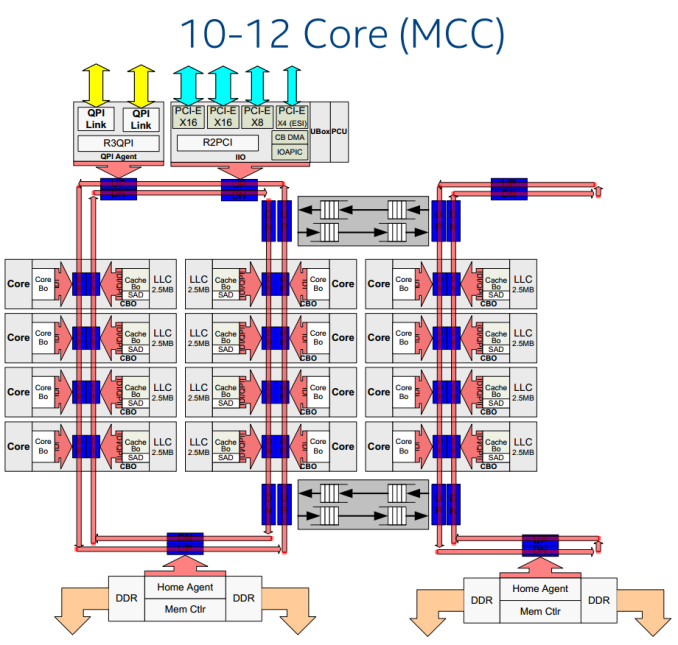
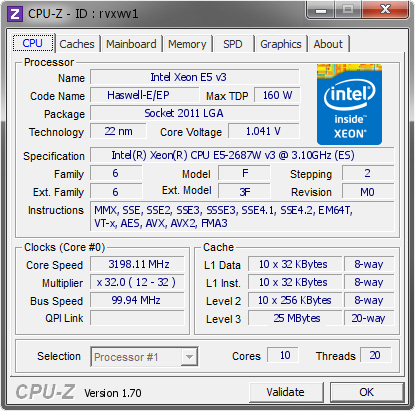
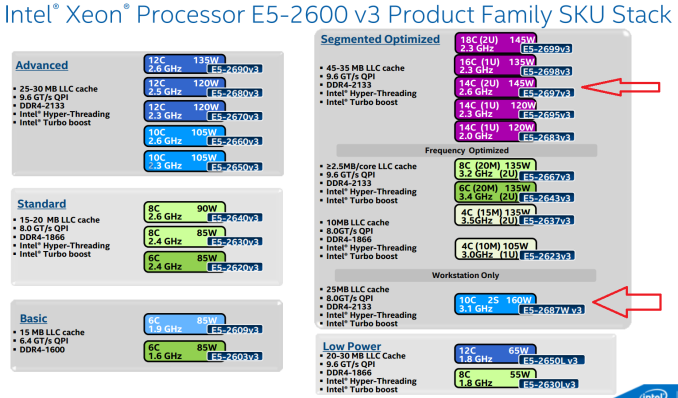
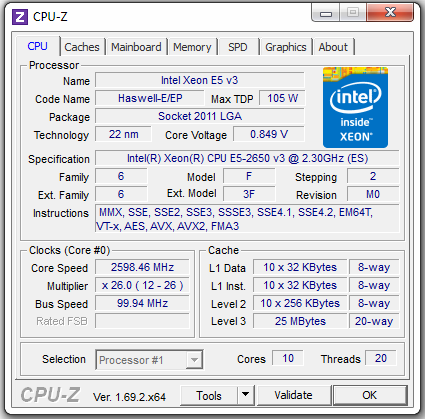
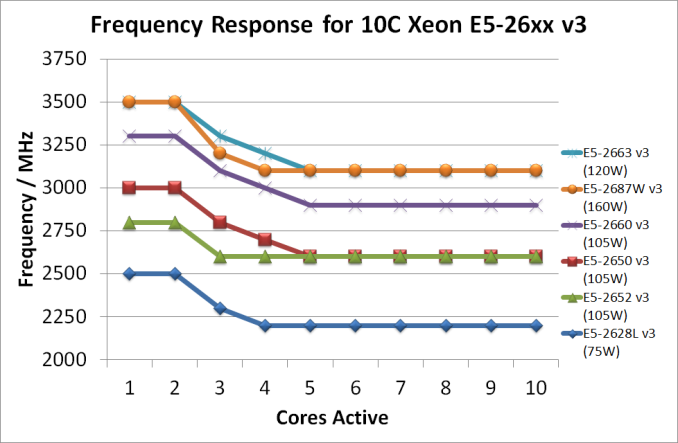

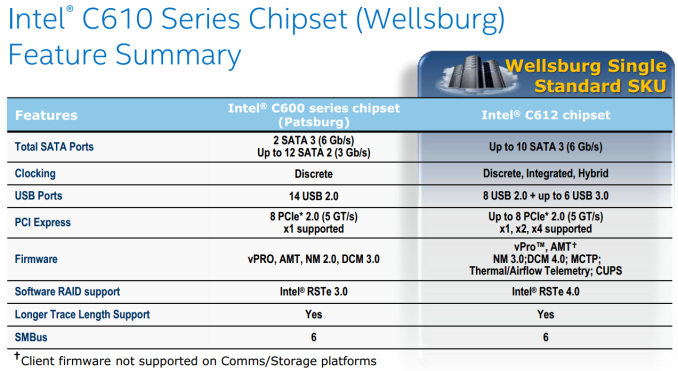
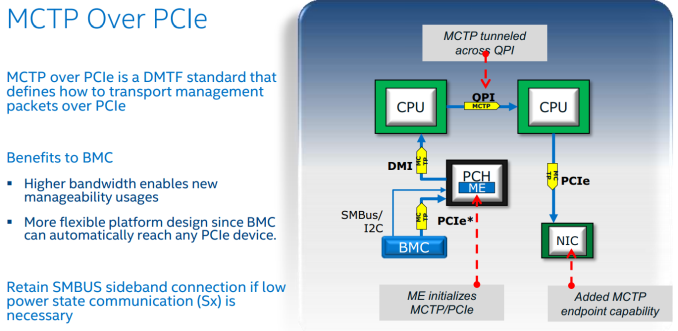
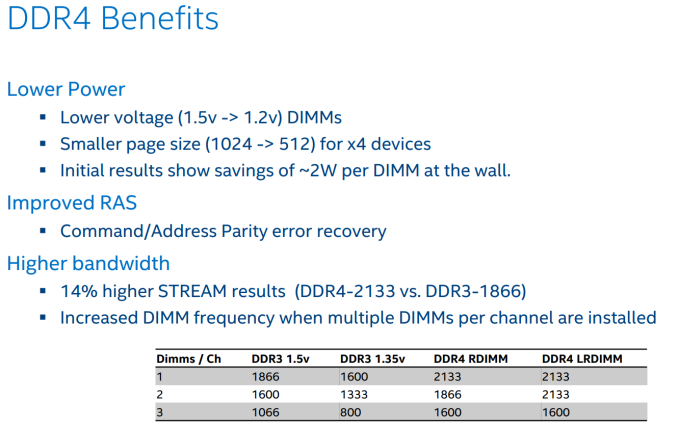








27 Comments
View All Comments
TiGr1982 - Wednesday, October 15, 2014 - link
This new workstation CPU, Xeon E5-2687W v3, as we see, is intended for multithreaded software.There are actually workstation CPUs better fitting for singlethreaded software: these are Xeon E3, e.g., Xeon E3-1286 v3 (3.7/4.1 GHz) and slower and cheaper models below it.
These are essentially "professionalized" Core i7s for LGA1150.
Being the same silicon as Core i7s for LGA1150, these E3s have their own downsides, however: only 32 GB of RAM and only 8 MB of L3 cache.
And the really fastest in single threaded tasks is Core i7-4790K at 4.0/4.4 GHz, but it lacks ECC memory support.
hrrmph - Tuesday, October 14, 2014 - link
I would like to encourage Ian and AT in general to continue to split the coverage (as they have been doing recently) for dual-socketed platforms into the "low-end" enthusiast / workstation segment, and the "high-end" more heavy-duty server / enterprise segment.Ian's recent articles hitting this from the "low-end" enthusiast / workstation angle have been really helpful to me, even though I've already been part-time "playing" with dual-socketed systems for some time, both as an educational exercise and a personal curiosity endeavor.
In particular, the effects of NUMA aware software on dual-socketed system performance are of great interest.
I've also noticed a lot of negative feedback to Ian's articles that I think is unwarranted. It's mostly from folks who want Ian to do more complex testing of more complex tasks that are primarily enterprise related. That's all well and good, but as I understand it, that is the job of the "other half" of AT to do.
Ian and AT doing dual-socketed articles on "low-end" Windows builds is exactly what we need to help people know whether or not they would like to "step-up" from X99-E. It also is helpful so that folks know what they are really getting into if they go the dual-socketed route. As Ian pointed out in recent articles there are still some things that X99-E will do better and going into dual-socketed computing all "starry-eyed" isn't necessarily the best way to approach it.
If there is anything that AT could use, it's actually even more comparative testing of X99 Haswell-E versus the C6xx Haswell-EP from a Windows workstation user's perspective. It would be great to see which taskings favored which platform in actual testing.
Everyone has an opinion, but actually doing it is the best way to demonstrate what works and what doesn't.
mapesdhs - Thursday, October 16, 2014 - link
Entirely agree! Good summary.
Btw, disappointing to see the threaded CB R15 result for the 2687W is only 30% better
than an oc'd 3930K (mine @ 4.7 gives 1221). Does confirm that to really best a 1-socket
oc'd i7, one really has to move to a multi-socket platform, and then of course it boils down
to whether the sw is written to match (eg. is Handbrake written as well as it could?)
Ian.
PS. I hasten to add, I'm a different Ian. :D
SanX - Tuesday, October 14, 2014 - link
"And remember this rule Pinnochio for the rest of your life -- two processors with the factor of 1.5 difference are equal"colonelclaw - Wednesday, October 15, 2014 - link
Any chance you could include V-Ray in future benchmarks? It's multi-application and multi-platform and very popular in the CGI world.mapesdhs - Thursday, October 16, 2014 - link
And of course c-ray, which scales extremely well with multiple cores.Ian.
otherwise - Monday, November 17, 2014 - link
In the future, is there any chance you can add a benchmark that stresses single-threaded integer performance? I'd love to see how much Int performance has changed from generation to generation, but most sites (including this one) seem to focus on FP performance.